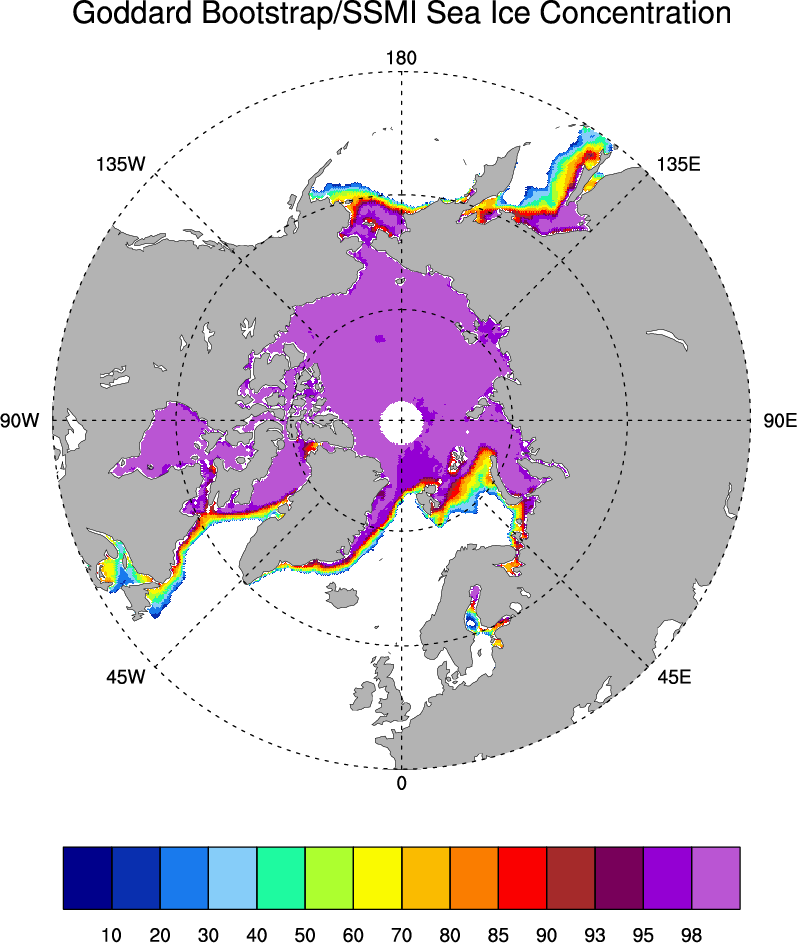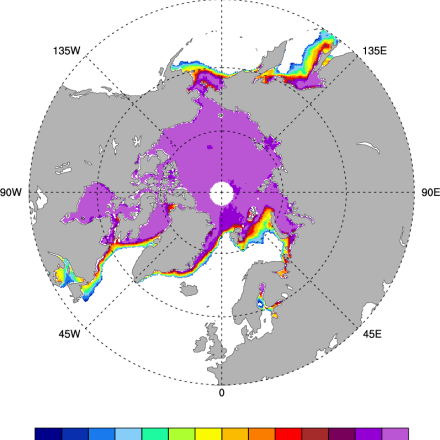Sea Ice Concentration data from NASA Goddard and NSIDC based on Bootstrap algorithm

Key Strengths
Key Limitations
From NSIDC: Comiso, J. 1999, updated 2012. Bootstrap Sea Ice Concentrations from Nimbus-7 SMMR and DMSP SSM/I-SSMIS, [list dates you used]. Boulder, Colorado USA: National Snow and Ice Data Center. Digital media.
- binary: stand-alone gridded data set at NSIDC (ftp)
- netCDF: gridded data, distributed by NSIDC with Climate Data Record
- Area and Extent daily and monthly timeseries at NSIDC
- NSIDC pixel area grids and geocoordinate tools (needed to calculate sea ice extent & area)
- Extent timeseries from JAXA based on Bootstrap, multiple instruments (SMMR, SSMI, AMSR-E, Windsat)
unrestricted; registration requested
Cite this page
Acknowledgement of any material taken from or knowledge gained from this page is appreciated:
National Center for Atmospheric Research Staff (Eds). Last modified "The Climate Data Guide: Sea Ice Concentration data from NASA Goddard and NSIDC based on Bootstrap algorithm.” Retrieved from https://climatedataguide.ucar.edu/climate-data/sea-ice-concentration-data-nasa-goddard-and-nsidc-based-bootstrap-algorithm on 2025-12-27.
Citation of datasets is separate and should be done according to the data providers' instructions. If known to us, data citation instructions are given in the Data Access section, above.
Acknowledgement of the Climate Data Guide project is also appreciated:
Schneider, D. P., C. Deser, J. Fasullo, and K. E. Trenberth, 2013: Climate Data Guide Spurs Discovery and Understanding. Eos Trans. AGU, 94, 121–122, https://doi.org/10.1002/2013eo130001
Key Figures
Other Information
- Cho, K., N. Sasaki, H. Shimoda, T. Sakata, and F. Nishio. 1996. Evaluation and Improvement of SSM/I Sea Ice Concentration Algorithms for the Sea of Okhotsk. Journal Remote Sensing of Japan 16(2):47-58.
- Comiso, J. C., and F. Nishio. 2008. Trends in the Sea Ice Cover Using Enhanced and Compatible AMSR-E, SSM/I, and SMMR Data. Journal of Geophysical Research 113, C02S07, doi:10.1029/2007JC0043257.
- Comiso, J. C. 1995. SSM/I Concentrations Using the Bootstrap Algorithm. NASA Reference Publication 1380. 40 pages.
